Satellite-Based Discrimination of Urban Dynamics-Induced Local Bias from Day/Night Temperature Trends across the Nile Delta, Egypt: A Basis for Climate Change Impacts Assessment
Abstract
:1. Introduction
2. Materials and Methods
2.1. Study Area
2.2. Datasets Description and Analysis Procedure
2.2.1. Urban Dynamics Data and Mapping
2.2.2. Vegetation Indices and Urban–Rural Distinction
2.2.3. LST Time-Series Construction
2.2.4. Trend Analysis
2.2.5. Local–Regional Warmings Separation
3. Results and Discussion
3.1. Urban Dynamics in the Overall Nile Delta
3.2. Day/Night and Urban/Rural LST Trends and the Nexus with Urban Dynamics
3.3. Urban Bias Estimation and Removal
4. Conclusions
Author Contributions
Funding
Conflicts of Interest
References
- Stanley, D.J.; Warne, A.G. Nile Delta in its Destruction Phase. J. Coast. Res. 1998, 14, 794–825. Available online: https://www.jstor.org/stable/4298835 (accessed on 28 March 2022).
- Fishar, M.R. Nile Delta (Egypt). In The Wetland Book: II: Distribution, Description, and Conservation; Finlayson, C.M., Milton, G.R., Prentice, R.C., Davidson, N.C., Eds.; Springer: Dordrecht, The Netherlands, 2018; pp. 1251–1260. [Google Scholar]
- IPCC. Climate Change: The IPCC Impacts Assessment. Canberra. 1990. Available online: https://www.ipcc.ch/site/assets/uploads/2018/03/ipcc_far_wg_II_full_report.pdf (accessed on 2 April 2022).
- IPCC. Climate Change 1995: Impacts, Adaptations and Mitigation of Climate Change: Scientific-Technical Analyses. Cambridge. 1995. Available online: https://www.ipcc.ch/site/assets/uploads/2018/03/ipcc_sar_wg_II_full_report.pdf (accessed on 2 April 2022).
- IPCC. Climate Change 2022: Impacts, Adaptation, and Vulnerability. Cambridge. 2022. Available online: https://www.ipcc.ch/report/ar6/wg2/downloads/report/IPCC_AR6_WGII_FinalDraft_FullReport.pdf. (accessed on 2 April 2022).
- IPCC. The Regional Impact of Climate Change: An Assessment of Vulnerability. Cambridge. 1997. Available online: https://www.ipcc.ch/site/assets/uploads/2020/11/The-Regional-Impact.pdf (accessed on 2 April 2022).
- IPCC. Climate Change 2001: Impacts, Adaptation, and Vulnerability. Cambridge. 2001. Available online: https://www.ipcc.ch/site/assets/uploads/2018/03/WGII_TAR_full_report-2.pdf (accessed on 2 April 2022).
- IPCC. Climate Change 2007: Impacts, Adaptation and Vulnerability. Cambridge. 2007. Available online: https://www.ipcc.ch/site/assets/uploads/2018/03/ar4_wg2_full_report.pdf (accessed on 2 April 2022).
- IPCC. Climate Change 2014: Impacts, Adaptation, and Vulnerability. Part A: Global and Sectoral Aspects. Contribution of Working Group II to the Fifth Assessment Report of the Intergovernmental Panel on Climate Change. Cambridge. 2014. Available online: https://www.ipcc.ch/site/assets/uploads/2018/02/WGIIAR5-PartA_FINAL.pdf (accessed on 2 April 2022).
- IPCC. Climate Change 2014: Impacts, Adaptation, and Vulnerability. Part B: Regional Aspects. Contribution of Working Group II to the Fifth Assessment Report of the Intergovernmental Panel on Climate Change. Cambridge. 2014. Available online: https://www.ipcc.ch/site/assets/uploads/2018/02/WGIIAR5-Chap21_FINAL.pdf (accessed on 2 April 2022).
- FAO. Climate Change and Food Security: Risks and Responses. Rome. 2015. Available online: https://www.fao.org/3/i5188e/I5188E.pdf (accessed on 4 April 2022).
- Ammann, P.; Dietler, D.; Winkler, M.S. Health impact assessment and climate change: A scoping review. J. Clim. Chang Health 2021, 3, 100045. [Google Scholar] [CrossRef]
- Maldonado-Erazo, C.P.; Álvarez-García, J.; Río-Rama, M.D.L.C.D.; Durán-Sánchez, A. Scientific Mapping on the Impact of Climate Change on Cultural and Natural Heritage: A Systematic Scientometric Analysis. Land 2021, 10, 76. [Google Scholar] [CrossRef]
- Chapman, A.; Darby, S. Evaluating sustainable adaptation strategies for vulnerable mega-deltas using system dynamics modelling: Rice agriculture in the Mekong Delta’s An Giang Province, Vietnam. Sci. Total Environ. 2016, 559, 326–338. [Google Scholar] [CrossRef] [PubMed] [Green Version]
- Szabo, S.; Brondizio, E.; Renaud, F.G.; Hetrick, S.; Nicholls, R.J.; Matthews, Z.; Tessler, Z.; Tejedor, A.; Sebesvari, Z.; Foufoula-Georgiou, E.; et al. Population dynamics, delta vulnerability and environmental change: Comparison of the Mekong, Ganges–Brahmaputra and Amazon delta regions. Sustain. Sci. 2016, 11, 539–554. [Google Scholar] [CrossRef] [Green Version]
- Cazcarro, I.; Arto, I.; Hazra, S.; Bhattacharya, R.N.; Adjei, P.O.-W.; Ofori-Danson, P.K.; Asenso, J.K.; Amponsah, S.K.; Khondker, B.; Raihan, S.; et al. Biophysical and Socioeconomic State and Links of Deltaic Areas Vulnerable to Climate Change: Volta (Ghana), Mahanadi (India) and Ganges-Brahmaputra-Meghna (India and Bangladesh). Sustainability 2018, 10, 893. [Google Scholar] [CrossRef] [Green Version]
- Arto, I.; García-Muros, X.; Cazcarro, I.; González-Eguino, M.; Markandya, A.; Hazra, S. The socioeconomic future of deltas in a changing environment. Sci. Total Environ. 2018, 648, 1284–1296. [Google Scholar] [CrossRef]
- El-Nahry, A.H.; Doluschitz, R. Climate change and its impacts on the coastal zone of the Nile Delta, Egypt. Environ. Earth Sci. 2009, 59, 1497–1506. [Google Scholar] [CrossRef]
- Abutaleb, K.A.A.; Mohammed, A.H.E.-S.; Ahmed, M.H.M. Climate Change Impacts, Vulnerabilities and Adaption Measures for Egypt’s Nile Delta. Earth Syst. Environ. 2018, 2, 183–192. [Google Scholar] [CrossRef]
- Kassem, H.S.; Bello, A.R.S.; Alotaibi, B.M.; Aldosri, F.O.; Straquadine, G.S. Climate Change Adaptation in the Delta Nile Region of Egypt: Implications for Agricultural Extension. Sustainability 2019, 11, 685. [Google Scholar] [CrossRef] [Green Version]
- Gouda, D.M. Climate Change, Agriculture and Rural Communities’ Vulnerability in the Nile Delta BT—Climate Change Impacts on Agriculture and Food Security in Egypt: Land and Water Resources—Smart Farming—Livestock, Fishery, and Aquaculture; Omran, E.-S.E., Negm, A.M., Eds.; Springer International Publishing: Cham, Switzerland, 2020; pp. 525–576. [Google Scholar]
- Kalnay, E.; Cai, M. Impact of urbanization and land-use change on climate. Nature 2003, 423, 528–531. [Google Scholar] [CrossRef] [PubMed]
- Zhao, M.; Zhou, Y.; Li, X.; Cheng, W.; Zhou, C.; Ma, T.; Li, M.; Huang, K. Mapping urban dynamics (1992–2018) in Southeast Asia using consistent nighttime light data from DMSP and VIIRS. Remote Sens. Environ. 2020, 248, 111980. [Google Scholar] [CrossRef]
- Zhao, M.; Cheng, C.; Zhou, Y.; Li, X.; Shen, S.; Song, C. A global dataset of annual urban extents (1992–2020) from harmonized nighttime lights. Earth Syst. Sci. Data 2022, 14, 517–534. [Google Scholar] [CrossRef]
- Vasisith, S. Detecting Urban Sprawl in the Middle Nile Delta Region to Assess the Effects on Egypt’s Agriculture; Central European University: Budapest, Hungary, 2018. [Google Scholar]
- Radwan, T.M.; Blackburn, G.A.; Whyatt, J.D.; Atkinson, P.M. Dramatic Loss of Agricultural Land Due to Urban Expansion Threatens Food Security in the Nile Delta, Egypt. Remote Sens. 2019, 11, 332. [Google Scholar] [CrossRef] [Green Version]
- Yang, L.; Qian, F.; Song, D.-X.; Zheng, K.-J. Research on Urban Heat-Island Effect. Procedia Eng. 2016, 169, 11–18. [Google Scholar] [CrossRef]
- De Almeida, C.R.; Teodoro, A.C.; Gonçalves, A. Study of the Urban Heat Island (UHI) Using Remote Sensing Data/Techniques: A Systematic Review. Environments 2021, 8, 105. [Google Scholar] [CrossRef]
- Rossi, F.; Cardinali, M.; Gambelli, A.M.; Filipponi, M.; Castellani, B.; Nicolini, A. Outdoor thermal comfort improvements due to innovative solar awning solutions: An experimental campaign. Energy Build. 2020, 225, 110341. [Google Scholar] [CrossRef]
- Karl, T.R.; Jones, P.D. Urban Bias in Area-averaged Surface Air Temperature Trends. Bull. Am. Meteorol. Soc. 1989, 70, 265–270. [Google Scholar] [CrossRef]
- Ya, Z. Identifying and Correcting Urban Bias for Regional Surface Air Temperature Series of North China over Period of 196Q_2000. Clim. Environ. Res. 2005, 10, 743–753. [Google Scholar]
- Shi, T.; Huang, Y.; Sun, D.; Lu, G.; Yang, Y. A New Method for Correcting Urbanization-Induced Bias in Surface Air Temperature Observations: Insights From Comparative Site-Relocation Data. Front. Environ. Sci. 2021, 9, 625418. [Google Scholar] [CrossRef]
- Janis, M.J. Observation-Time-Dependent Biases and Departures for Daily Minimum and Maximum Air Temperatures. J. Appl. Meteorol. 2002, 41, 588–603. Available online: http://www.jstor.org/stable/26184999 (accessed on 20 March 2022). [CrossRef]
- Vose, R.S.; Williams, C.N.; Peterson, T.C.; Karl, T.R.; Easterling, D.R. An evaluation of the time of observation bias adjustment in the U.S. Historical Climatology Network. Geophys. Res. Lett. 2003, 30, 2046. [Google Scholar] [CrossRef]
- Böhm, R.; Jones, P.D.; Hiebl, J.; Frank, D.; Brunetti, M.; Maugeri, M. The early instrumental warm-bias: A solution for long central European temperature series 1760–2007. Clim. Chang. 2010, 101, 41–67. [Google Scholar] [CrossRef]
- Dienst, M.; Lindén, J.; Engström, E.; Esper, J. Removing the relocation bias from the 155-year Haparanda temperature record in Northern Europe: Removing the relocation bias from a 155-year temperature record. Int. J. Climatol. 2017, 37, 4015–4026. [Google Scholar] [CrossRef]
- Kukla, G.; Gavin, J.; Karl, T.R. Urban Warming. J. Clim. Appl. Meteorol. 1986, 25, 1265–1270. [Google Scholar] [CrossRef]
- Karl, T.R.; Diaz, H.F.; Kukla, G. Urbanization: Its Detection and Effect in the United States Climate Record. J. Clim. 1988, 1, 1099–1123. [Google Scholar] [CrossRef]
- Jones, P.D.; Kelly, P.M.; Goodess, C.M.; Karl, T. The Effect of Urban Warming on the Northern Hemisphere Temperature Average. J. Clim. 1989, 2, 285–290. Available online: http://www.jstor.org/stable/26195817 (accessed on 1 March 2022). [CrossRef]
- Landsberg, H.E. The Climate of Towns. Man’s Role in Changing the Face of the Earth; Hutchinson: London, UK, 1956; pp. 584–603. [Google Scholar]
- Ren, G.; Zhou, Y.; Chu, Z.; Zhou, J.; Zhang, A.; Guo, J.; Liu, X. Urbanization Effects on Observed Surface Air Temperature Trends in North China. J. Clim. 2008, 21, 1333–1348. [Google Scholar] [CrossRef] [Green Version]
- Wang, J.; Yan, Z.-W. Urbanization-related warming in local temperature records: A review. Atmos. Ocean. Sci. Lett. 2015, 9, 129–138. [Google Scholar] [CrossRef] [Green Version]
- Brázdil, R.; Budíková, M. An urban bias in air temperature fluctuations at the Klementinum, Prague, The Czech Republic. Atmos. Environ. 1999, 33, 4211–4217. [Google Scholar] [CrossRef]
- Choi, Y.; Jung, H.-S.; Nam, K.-Y.; Kwon, W.-T. Adjusting urban bias in the regional mean surface temperature series of South Korea, 1968–1999. Int. J. Clim. 2003, 23, 577–591. [Google Scholar] [CrossRef]
- Portman, D.A. Identifying and Correcting Urban Bias in Regional Time Series: Surface Temperature in China’s Northern Plains. J. Clim. 1993, 6, 2298–2308. [Google Scholar] [CrossRef]
- Peterson, T.C. Assessment of Urban Versus Rural In Situ Surface Temperatures in the Contiguous United States: No Difference Found. J. Clim. 2003, 16, 2941–2959. [Google Scholar] [CrossRef]
- Manalo, J.A.; Matsumoto, J.; Takahashi, H.G.; Ii, M.Q.V.; Olaguera, L.M.P.; Ren, G.; Cinco, T.A. The effect of urbanization on temperature indices in the Philippines. Int. J. Clim. 2021, 42, 850–867. [Google Scholar] [CrossRef]
- Zhang, P.; Ren, G.; Qin, Y.; Zhai, Y.; Zhai, T.; Tysa, S.K.; Xue, X.; Yang, G.; Sun, X. Urbanization Effects on Estimates of Global Trends in Mean and Extreme Air Temperature. J. Clim. 2021, 34, 1923–1945. [Google Scholar] [CrossRef]
- Epperson, D.L.; Davis, J.M.; Bloomfield, P.; Karl, T.R.; McNab, A.L.; Gallo, K.P. Estimating the Urban Bias of Surface Shelter Temperatures Using Upper-Air and Satellite Data. Part I: Development of Models Predicting Surface Shelter Temperatures. J. Appl. Meteorol. 1995, 34, 340–357. [Google Scholar] [CrossRef] [Green Version]
- Epperson, D.L.; Davis, J.M.; Bloomfield, P.; Karl, T.R.; McNab, A.L.; Gallo, K.P. Estimating the Urban Bias of Surface Shelter Temperatures Using Upper-Air and Satellite Data. Part II: Estimation of the Urban Bias. J. Appl. Meteorol. 1995, 34, 358–370. [Google Scholar] [CrossRef]
- Parker, D.E. Urban heat island effects on estimates of observed climate change. WIREs Clim. Chang. 2009, 1, 123–133. [Google Scholar] [CrossRef]
- Yuan, Z.; Guo-Yu, R.E.N. Correcting urban bias for surface air temperature series of Beijing Station over time period 1915–2012. Chin. J. Geophys. 2014, 57, 2197–2207. (In Chinese) [Google Scholar] [CrossRef]
- Wang, J.; Tett, S.F.B.; Yan, Z. Correcting urban bias in large-scale temperature records in China, 1980-2009. Geophys. Res. Lett. 2017, 44, 401–408. [Google Scholar] [CrossRef] [Green Version]
- Hamdi, R.; Van De Vyver, H. Estimating urban heat island effects on near-surface air temperature records of Uccle (Brussels, Belgium): An observational and modeling study. Adv. Sci. Res. 2011, 6, 27–34. [Google Scholar] [CrossRef] [Green Version]
- Bassett, R.; Young, P.J.; Blair, G.S.; Cai, X.-M.; Chapman, L. Urbanisation’s contribution to climate warming in Great Britain. Environ. Res. Lett. 2020, 15, 114014. [Google Scholar] [CrossRef]
- National Research Council; Division on Earth and Life Studies; Board on Atmospheric Sciences and Climate; Committee on Scientific Accomplishments of Earth Observations from Space. Earth Observations from Space: The First 50 Years of Scientific Achievements; National Academies Press: Washington, DC, USA, 2008.
- Li, G.; Cao, C. Development of environmental monitoring satellite systems in China. Sci. China Earth Sci. 2010, 53, 1–7. [Google Scholar] [CrossRef]
- Guo, H.-D.; Zhang, L.; Zhu, L.-W. Earth observation big data for climate change research. Adv. Clim. Chang. Res. 2015, 6, 108–117. [Google Scholar] [CrossRef]
- Young, R.; Onoda, M. Satellite Earth Observations in Environmental Problem-Solving BT—Satellite Earth Observations and Their Impact on Society and Policy; Springer: Singapore, 2017; pp. 3–27. [Google Scholar]
- Andries, A.; Murphy, R.J.; Morse, S.; Lynch, J. Earth Observation for Monitoring, Reporting, and Verification within Environmental Land Management Policy. Sustainability 2021, 13, 9105. [Google Scholar] [CrossRef]
- Huzui, A.E.; Abdelkader, A.; Pătru-Stupariu, I. Analysing urban dynamics using multi-temporal satellite images in the case of a mountain area, Sinaia (Romania). Int. J. Digit. Earth 2013, 6, 563–579. [Google Scholar] [CrossRef]
- Cao, W.; Zhou, Y. Remote Sensing of Urban Dynamics. In Landscape and Land Capacity; Taylor & Francis Group: Abingdon, UK, 2020; pp. 387–391. [Google Scholar]
- Chaudhuri, G.; Mainali, K.P.; Mishra, N.B. Analyzing the dynamics of urbanization in Delhi National Capital Region in India using satellite image time-series analysis. Environ. Plan. B Urban Anal. City Sci. 2021, 49, 368–384. [Google Scholar] [CrossRef]
- Lin, X.; Xu, M.; Cao, C.; Singh, R.P.; Chen, W.; Ju, H. Land-Use/Land-Cover Changes and Their Influence on the Ecosystem in Chengdu City, China during the Period of 1992–2018. Sustainability 2018, 10, 3580. [Google Scholar] [CrossRef] [Green Version]
- Twisa, S.; Buchroithner, M.F. Land-Use and Land-Cover (LULC) Change Detection in Wami River Basin, Tanzania. Land 2019, 8, 136. [Google Scholar] [CrossRef] [Green Version]
- Inalpulat, M.; Genc, L. Quantification of LULC Changes and Urbanization Effects on Agriculture Using Historical Landsat Data in North-West Anatolia, Turkey. Pol. J. Environ. Stud. 2021, 30, 3999–4007. [Google Scholar] [CrossRef]
- Kuenzer, C.; Dech, S. (Eds.) Thermal Infrared Remote Sensing: Sensors, Methods, Applications, 1st ed.; Springer: Dordrecht, The Netherlands, 2013. [Google Scholar]
- Tang, H.; Li, Z.-L. Quantitative Remote Sensing in Thermal Infrared: Theory and Applications; Springer: Berlin/Heidelberg, Germany, 2014. [Google Scholar]
- Weng, Q.; Larson, R.C. Satellite Remote Sensing of Urban Heat Islands: Current Practice and Prospects BT—Geo-Spatial Technologies in Urban Environments; Jensen, R.R., Gatrell, J.D., McLean, D.D., Eds.; Springer: Berlin/Heidelberg, Germany, 2005; pp. 91–111. [Google Scholar]
- Imhoff, M.L.; Zhang, P.; Wolfe, R.E.; Bounoua, L. Remote sensing of the urban heat island effect across biomes in the continental USA. Remote Sens. Environ. 2010, 114, 504–513. [Google Scholar] [CrossRef] [Green Version]
- Zhou, D.; Xiao, J.; Bonafoni, S.; Berger, C.; Deilami, K.; Zhou, Y.; Frolking, S.; Yao, R.; Qiao, Z.; Sobrino, J.A. Satellite Remote Sensing of Surface Urban Heat Islands: Progress, Challenges, and Perspectives. Remote Sens. 2019, 11, 48. [Google Scholar] [CrossRef]
- Abulibdeh, A. Analysis of urban heat island characteristics and mitigation strategies for eight arid and semi-arid gulf region cities. Environ. Earth Sci. 2021, 80, 259. [Google Scholar] [CrossRef]
- Hung, T.; Uchihama, D.; Ochi, S.; Yasuoka, Y. Assessment with satellite data of the urban heat island effects in Asian mega cities. Int. J. Appl. Earth Obs. Geoinf. 2006, 8, 34–48. [Google Scholar] [CrossRef]
- Zhou, D.; Zhao, S.; Zhang, L.; Sun, G.; Liu, Y. The footprint of urban heat island effect in China. Sci. Rep. 2015, 5, 11160. [Google Scholar] [CrossRef] [Green Version]
- Sfîcă, L.; Ichim, P.; Apostol, L.; Ursu, A. The extent and intensity of the urban heat island in Iași city, Romania. Arch. Meteorol. Geophys. Bioclimatol. Ser. B 2017, 134, 777–791. [Google Scholar] [CrossRef]
- Qiao, Z.; Wu, C.; Zhao, D.; Xu, X.; Yang, J.; Feng, L.; Sun, Z.; Liu, L. Determining the Boundary and Probability of Surface Urban Heat Island Footprint Based on a Logistic Model. Remote Sens. 2019, 11, 1368. [Google Scholar] [CrossRef] [Green Version]
- Yang, Q.; Huang, X.; Tang, Q. The footprint of urban heat island effect in 302 Chinese cities: Temporal trends and associated factors. Sci. Total Environ. 2018, 655, 652–662. [Google Scholar] [CrossRef] [PubMed]
- Kottek, M.; Grieser, J.; Beck, C.; Rudolf, B.; Rubel, F. World map of the Köppen-Geiger climate classification updated. Meteorol. Z. 2006, 15, 259–263. [Google Scholar] [CrossRef]
- Gong, P.; Wang, J.; Yu, L.; Zhao, Y.; Zhao, Y.; Liang, L.; Niu, Z.; Huang, X.; Fu, H.; Liu, S.; et al. Finer resolution observation and monitoring of global land cover: First mapping results with Landsat TM and ETM+ data. Int. J. Remote Sens. 2013, 34, 2607–2654. [Google Scholar] [CrossRef] [Green Version]
- Chen, J.; Chen, J.; Liao, A.; Cao, X.; Chen, L.; Chen, X.; He, C.; Han, G.; Peng, S.; Lu, M.; et al. Global land cover mapping at 30 m resolution: A POK-based operational approach. ISPRS J. Photogramm. Remote Sens. 2015, 103, 7–27. [Google Scholar] [CrossRef] [Green Version]
- Gong, P.; Li, X.; Wang, J.; Bai, Y.; Chen, B.; Hu, T.; Liu, X.; Xu, B.; Yang, J.; Zhang, W.; et al. Annual maps of global artificial impervious area (GAIA) between 1985 and 2018. Remote Sens. Environ. 2019, 236, 111510. [Google Scholar] [CrossRef]
- Shi, T.; Huang, Y.; Wang, H.; Shi, C.-E.; Yang, Y.-J. Influence of urbanization on the thermal environment of meteorological station: Satellite-observed evidence. Adv. Clim. Chang. Res. 2015, 6, 7–15. [Google Scholar] [CrossRef]
- Yang, Y.; Zhang, M.; Li, Q.; Chen, B.; Gao, Z.; Ning, G.; Liu, C.; Li, Y.; Luo, M. Modulations of surface thermal environment and agricultural activity on intraseasonal variations of summer diurnal temperature range in the Yangtze River Delta of China. Sci. Total Environ. 2020, 736, 139445. [Google Scholar] [CrossRef]
- Mudelsee, M. Trend analysis of climate time series: A review of methods. Earth-Sci. Rev. 2018, 190, 310–322. [Google Scholar] [CrossRef]
- Song, Z.; Chen, L.; Wang, Y.; Liu, X.; Lin, L.; Luo, M. Effects of urbanization on the decrease in sunshine duration over eastern China. Urban Clim. 2019, 28, 100471. [Google Scholar] [CrossRef]
- Kim, S.W.; Jung, D.; Choung, Y.-J. Development of a Multiple Linear Regression Model for Meteorological Drought Index Estimation Based on Landsat Satellite Imagery. Water 2020, 12, 3393. [Google Scholar] [CrossRef]
- Malik, S.; Pal, S.C.; Sattar, A.; Singh, S.K.; Das, B.; Chakrabortty, R.; Mohammad, P. Trend of extreme rainfall events using suitable Global Circulation Model to combat the water logging condition in Kolkata Metropolitan Area. Urban Clim. 2020, 32, 100599. [Google Scholar] [CrossRef]
- Tong, X.; Wang, P.; Wu, S.; Luo, M. Urbanization effects on high-frequency temperature variability over South China. Urban Clim. 2022, 42, 101092. [Google Scholar] [CrossRef]
- Mann, H.B. Nonparametric tests against trend. Econometrica 1945, 13, 245–259. [Google Scholar] [CrossRef]
- Kendall, M.G. Rank Correlation Methods, 4th ed.; Charles Griffin: London, UK, 1975. [Google Scholar]
- Theil, H. A Rank-Invariant Method of Linear and Polynomial Regression Analysis. In Proceedings of the Koninklijke Nederlandse Akademie Wetenschappen, Series A Mathematical Sciences, Amsterdam, The Netherlands; 1950; pp. 386–392. [Google Scholar]
- Sen, P.K. Estimates of the regression coefficient based on Kendall’s tau. J. Am. Stat. Assoc. 1968, 63, 1379–1389. [Google Scholar] [CrossRef]
- Hipel, K.W.; McLeod, A.I. (Eds.) Chapter 23 Nonparametric Tests for Trend Detection. In Time Series Modelling of Water Resources and Environmental Systems; Elsevier: Amsterdam, The Netherlands, 1994; Volume 45, pp. 853–938. [Google Scholar]
- Wang, F.; Shao, W.; Yu, H.; Kan, G.; He, X.; Zhang, D.; Ren, M.; Wang, G. Re-evaluation of the Power of the Mann-Kendall Test for Detecting Monotonic Trends in Hydrometeorological Time Series. Front. Earth Sci. 2020, 8, 14. [Google Scholar] [CrossRef]
- Ahmad, I.; Tang, D.; Wang, T.; Wang, M.; Wagan, B. Precipitation Trends over Time Using Mann-Kendall and Spearman’s rho Tests in Swat River Basin, Pakistan. Adv. Meteorol. 2015, 2015, 1–15. [Google Scholar] [CrossRef] [Green Version]
- Mohsin, T.; Gough, W.A. Characterization and estimation of urban heat island at Toronto: Impact of the choice of rural sites. Arch. Meteorol. Geophys. Bioclimatol. Ser. B 2011, 108, 105–117. [Google Scholar] [CrossRef]
- Chervenkov, H.; Slavov, K. Theil–Sen estimator vs. Ordinary least squares—Trend analysis for selected ETCCDI climate indices. Comptes Rendus Acad. Bulg. Sci. 2019, 72, 47–54. [Google Scholar] [CrossRef]
- Redeker, C.; Kantoush, S.A. The Nile Delta: Urbanizing on Diminishing Resources. Built Environ. 2014, 40, 201–212. Available online: http://www.jstor.org/stable/43296887 (accessed on 25 February 2022). [CrossRef]
- Sultan, M.; Fiske, M.; Stein, T.; Gamal, M.; El Araby, H.; Madani, A.; Mehanee, S.; Becker, R. Monitoring the urbanization of the Nile Delta, Egypt. Ambio 1999, 28. Available online: https://www.ostgov/biblio/942608 (accessed on 5 March 2022).
- Shalaby, A.; Moghanm, F.S. Assessment of urban sprawl on agricultural soil of northern Nile Delta of Egypt using RS and GIS. Chin. Geogr. Sci. 2015, 25, 274–282. [Google Scholar] [CrossRef] [Green Version]
- Elagouz, M.; Abou-Shleel, S.; Belal, A.; El-Mohandes, M. Detection of land use/cover change in Egyptian Nile Delta using remote sensing. Egypt. J. Remote Sens. Space Sci. 2019, 23, 57–62. [Google Scholar] [CrossRef]
- Nasrallah, H.A.; Brazel, A.J.; Balling, R.C. Analysis of the Kuwait city urban heat island. Int. J. Clim. 1990, 10, 401–405. [Google Scholar] [CrossRef]
- Cheng, W.L.; Saleem, A.; Sadr, R. Recent warming trend in the coastal region of Qatar. Theor. Appl. Climatol. 2017, 128, 193–205. [Google Scholar] [CrossRef] [Green Version]
- Almazroui, M.; Islam, M.N.; Jones, P.D. Urbanization effects on the air temperature rise in Saudi Arabia. Clim. Chang. 2013, 120, 109–122. [Google Scholar] [CrossRef]
- Benas, N.; Chrysoulakis, N.; Cartalis, C. Trends of urban surface temperature and heat island characteristics in the Mediterranean. Arch. Meteorol. Geophys. Bioclimatol. Ser. B 2016, 130, 807–816. [Google Scholar] [CrossRef]
- Siddiqui, A.; Kushwaha, G.; Nikam, B.; Srivastav, S.; Shelar, A.; Kumar, P. Analysing the day/night seasonal and annual changes and trends in land surface temperature and surface urban heat island intensity (SUHII) for Indian cities. Sustain. Cities Soc. 2021, 75, 103374. [Google Scholar] [CrossRef]
- Oke, T.R. The energetic basis of the urban heat island. Q. J. R. Meteorol. Soc. 1982, 108, 1–24. [Google Scholar] [CrossRef]
- Van Hove, L.W.A.; Jacobs, C.M.J.; Heusinkveld, B.G.; Elbers, J.A.; van Driel, B.L.; Holtslag, A.A.M. Temporal and spatial variability of urban heat island and thermal comfort within the Rotterdam agglomeration. Build. Environ. 2015, 83, 91–103. [Google Scholar] [CrossRef] [Green Version]
- Chen, X.; Jeong, S.-J. Shifting the urban heat island clock in a megacity: A case study of Hong Kong. Environ. Res. Lett. 2017, 13, 014014. [Google Scholar] [CrossRef]
- Abbas, W.; Ismael, H. Assessment of constructing canopy urban heat island temperatures from thermal images: An integrated multi-scale approach. Sci. Afr. 2020, 10, e00607. [Google Scholar] [CrossRef]
- Parlow, E. Regarding Some Pitfalls in Urban Heat Island Studies Using Remote Sensing Technology. Remote Sens. 2021, 13, 3598. [Google Scholar] [CrossRef]
- Easterling, D.R.; Horton, B.; Jones, P.D.; Peterson, T.C.; Karl, T.R.; Parker, D.E.; Salinger, M.J.; Razuvayev, V.; Plummer, N.; Jamason, P.; et al. Maximum and minimum temperature trends for the globe. Science 1997, 277, 364–367. [Google Scholar] [CrossRef] [Green Version]
- Jones, P.D.; Groisman, P.Y.; Coughlan, M.; Plummer, N.; Wang, W.-C.; Karl, T.R. Assessment of urbanization effects in time series of surface air temperature over land. Nature 1990, 347, 169–172. [Google Scholar] [CrossRef]
- Parker, D.E. Large-scale warming is not urban. Nature 2004, 432, 290. [Google Scholar] [CrossRef] [PubMed]
- Parker, D.E. A Demonstration That Large-Scale Warming Is Not Urban. J. Clim. 2006, 19, 2882–2895. [Google Scholar] [CrossRef]
- Wickham, C.; Rohde, R.; Muller, R.A.; Wurtele, J.; Curry, J.; Groom, D.; Jacobsen, R.; Perlmutter, S.; Rosenfeld, A.; Mosher, S. SInfluence of Urban Heating on the Global Temperature Land Average using Rural Sites Identified from MODIS Classifications. Geoinform. Geostat. Overv. 2013, 1. [Google Scholar] [CrossRef] [Green Version]
- Peterson, T.C.; Gallo, K.P.; Lawrimore, J.; Owen, T.W.; Huang, A.; McKittrick, D.A. Global rural temperature trends. Geophys. Res. Lett. 1999, 26, 329–332. [Google Scholar] [CrossRef] [Green Version]
- Zhang, Q.; Wu, Z.; Singh, V.P.; Liu, C. Impacts of Spatial Configuration of Land Surface Features on Land Surface Temperature across Urban Agglomerations, China. Remote Sens. 2021, 13, 4008. [Google Scholar] [CrossRef]
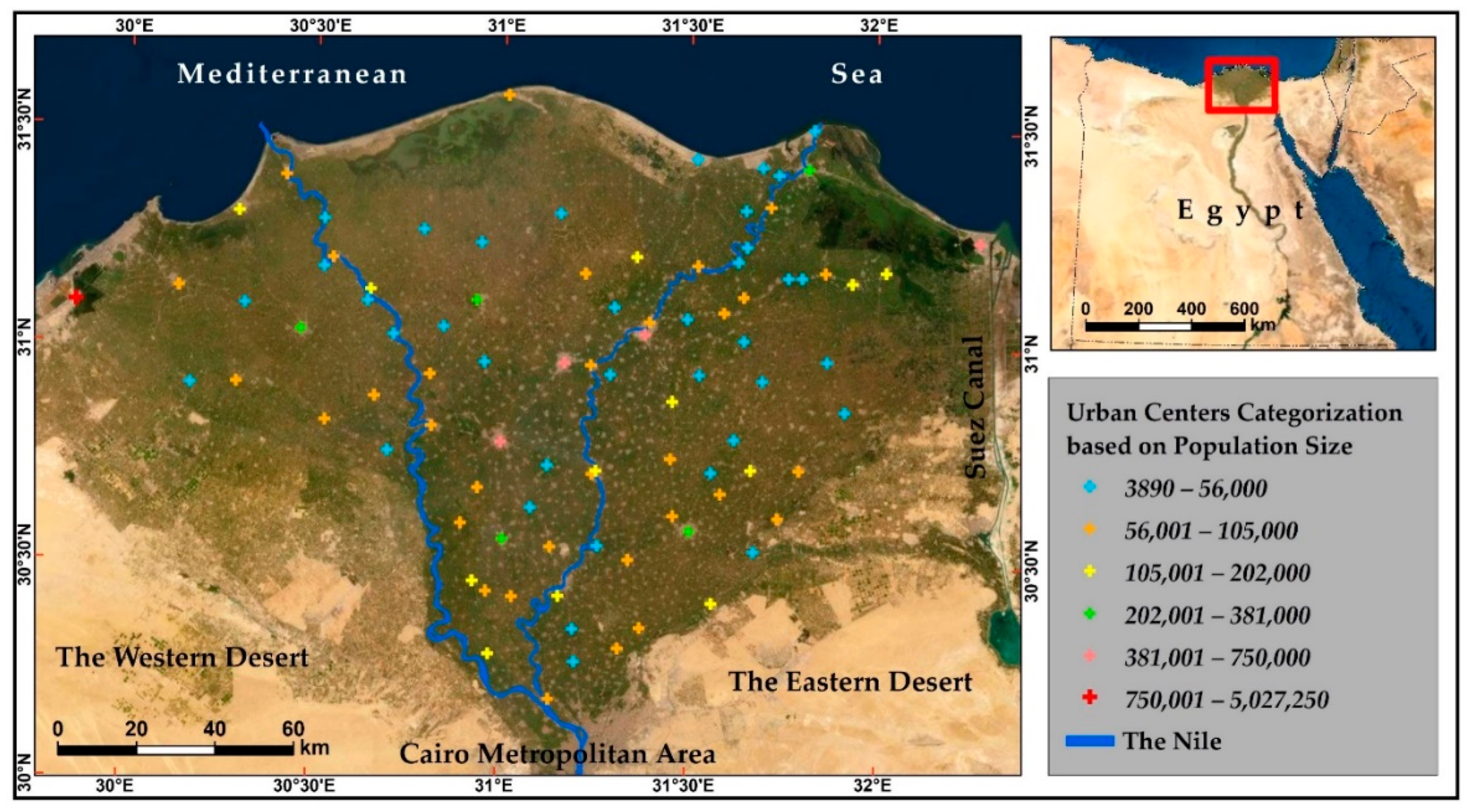
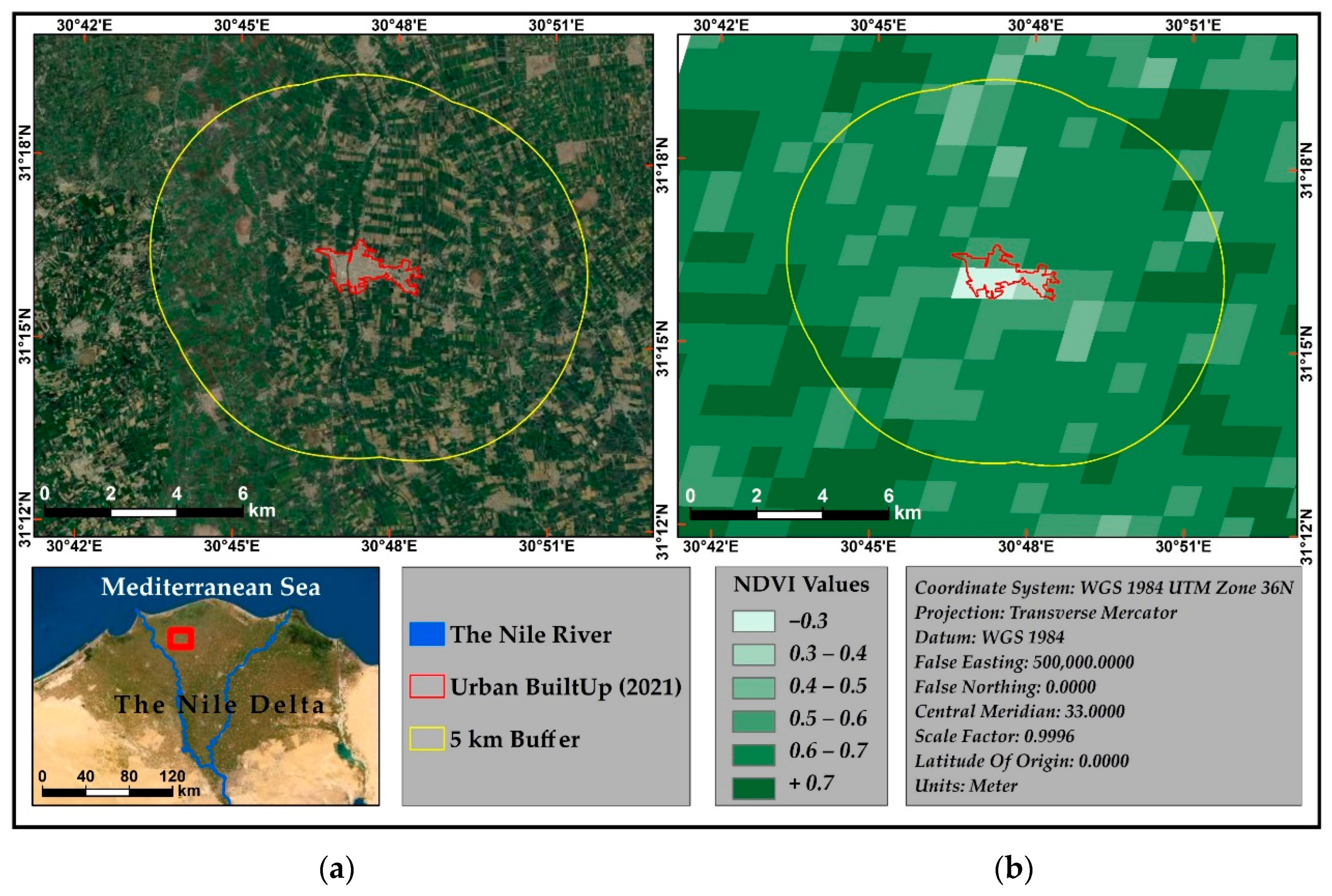
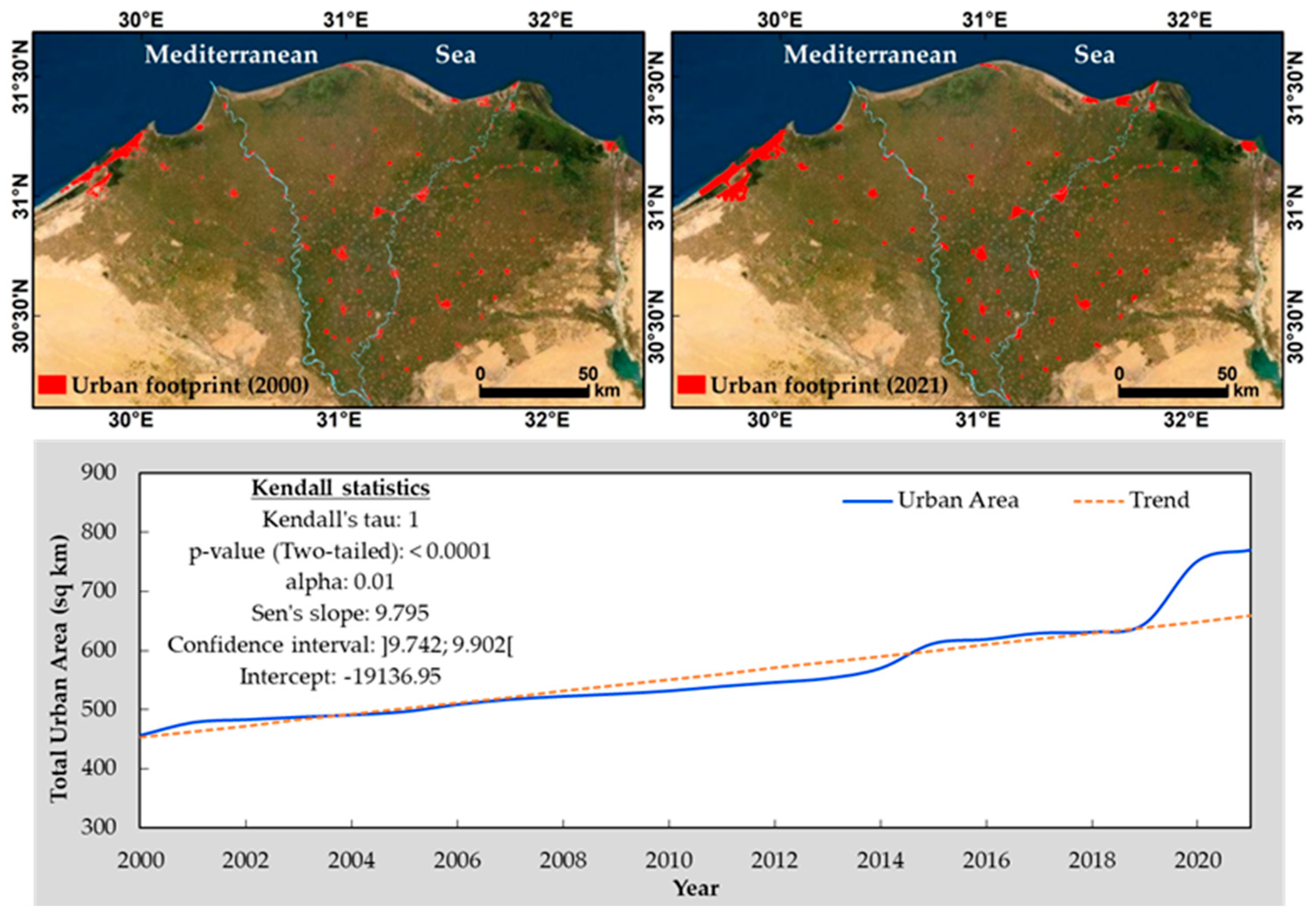
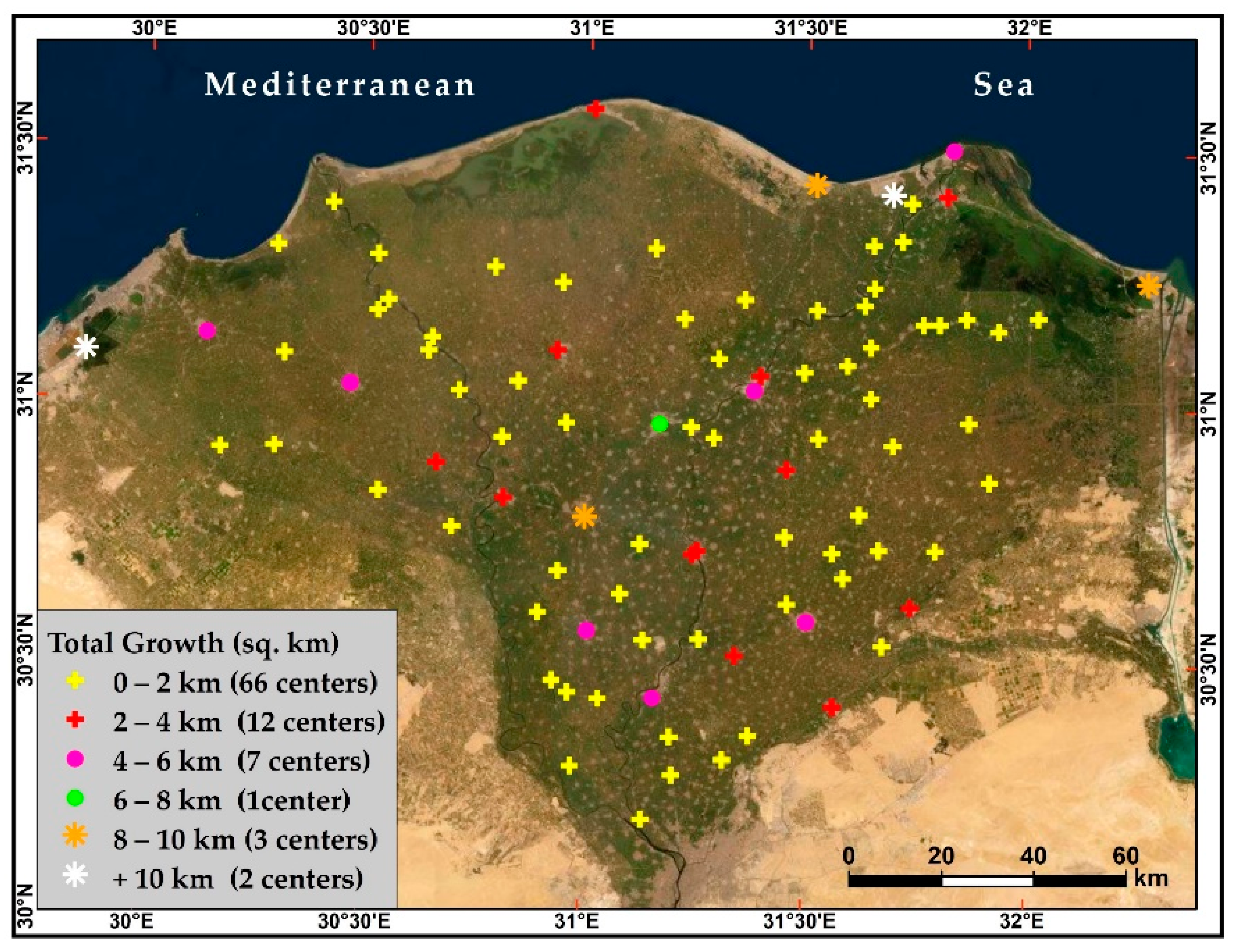
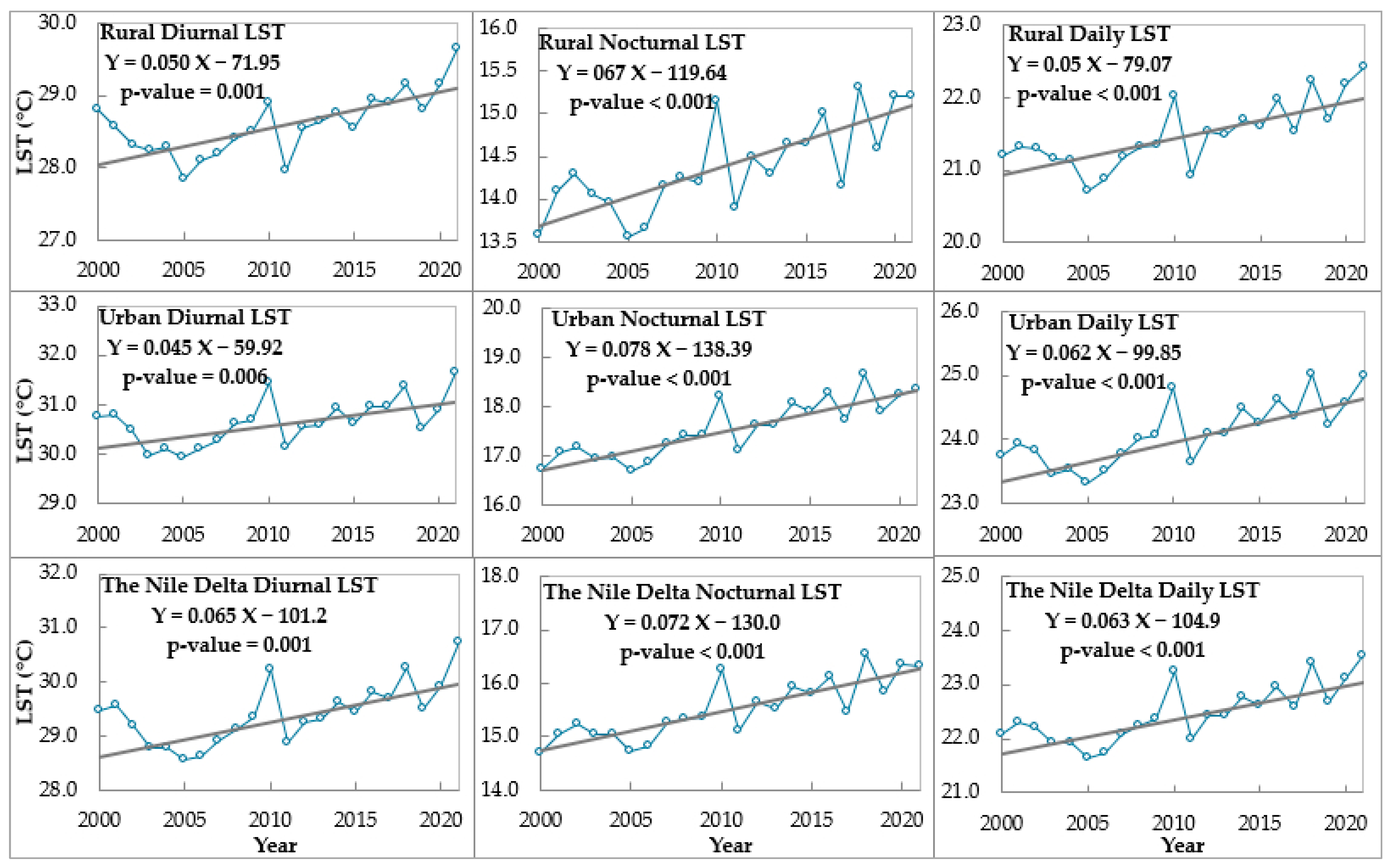
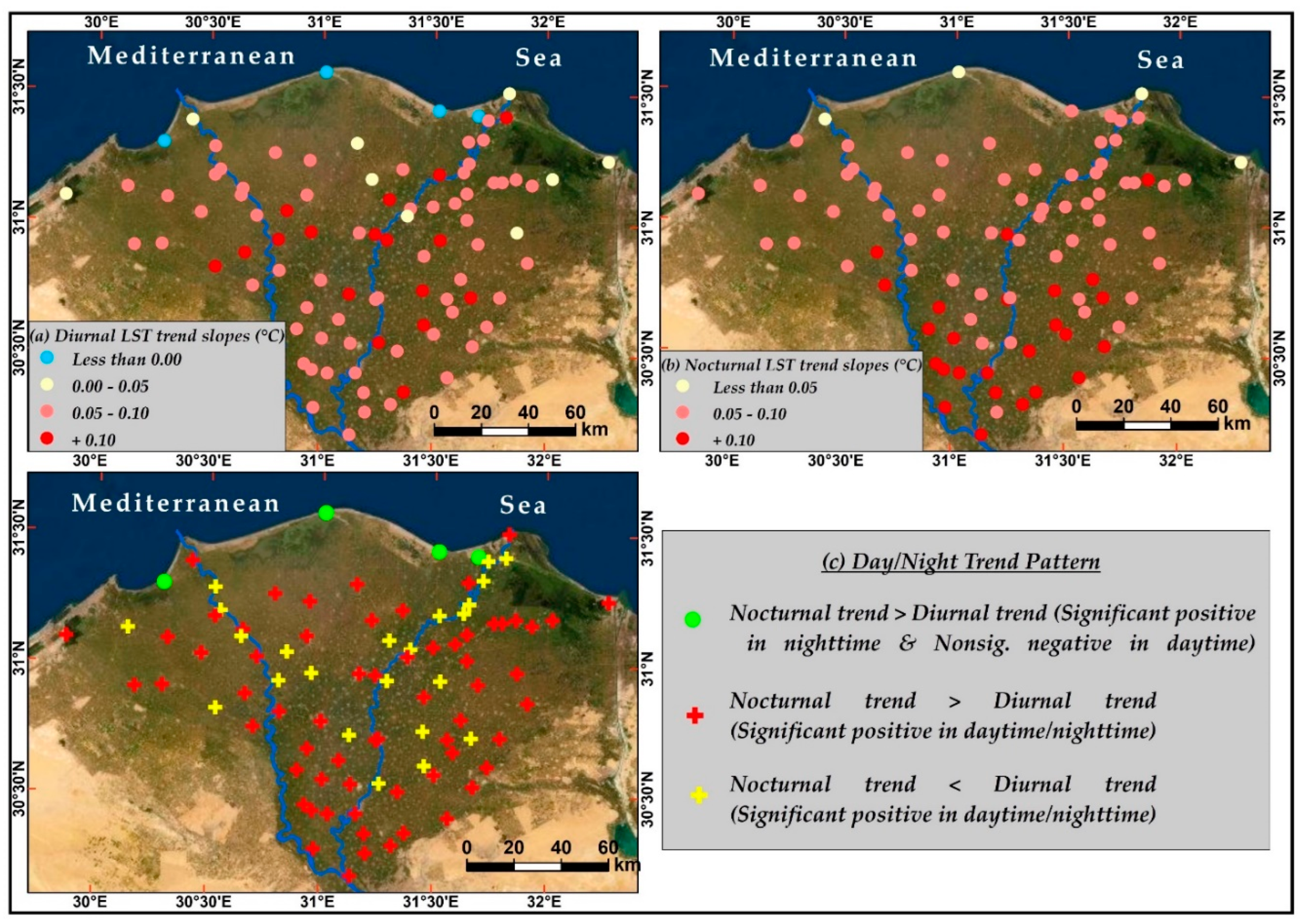


| Statistics | Item | Rural LST (°C) | Urban LST (°C) | The Nile Delta LST (°C) | ||||||
|---|---|---|---|---|---|---|---|---|---|---|
| Day | Night | Daily | Day | Night | Daily | Day | Night | Daily | ||
| Descriptive | Obs. | 22 | 22 | 22 | 22 | 22 | 22 | 22 | 22 | 22 |
| Min. | 27.9 (2005) | 13.5 (2000/5) | 20.7 (2005) | 29.9 (2005) | 16.7 (2000/5) | 23.3 (2005) | 28.6 (2005) | 14.7 (2000/5) | 21.6 (2005) | |
| Max. | 29.7 (2021) | 15.3 (2018) | 22.4 (2021) | 31.6 (2021) | 18.6 (2018) | 25.0 (2018/21) | 30.7 (2021) | 16.5 (2018) | 23.5 (2021) | |
| Mean | 28.6 | 14.4 | 21.5 | 30.7 | 17.6 | 24.1 | 29.4 | 15.5 | 22.5 | |
| Std. dev. | 0.4 | 0.5 | 0.5 | 0.5 | 0.6 | 0.5 | 0.6 | 0.6 | 0.5 | |
| Trend | K. tau | 0.51 | 0.57 | 0.60 | 0.43 | 0.70 | 0.62 | 0.51 | 0.68 | 0.62 |
| S | 116.0 | 131.0 | 139.0 | 99.0 | 161.0 | 143.0 | 117.0 | 157.0 | 143.0 | |
| Var(S) | 1254.7 | 1255.7 | 1255.7 | 1257.7 | 1257.7 | 1257.7 | 1257.7 | 1257.7 | 1257.7 | |
| p-value | 0.001 | <0.001 | <0.001 | 0.006 | <0.001 | <0.001 | 0.001 | <0.001 | <0.001 | |
| alpha | 0.01 | 0.01 | 0.01 | 0.01 | 0.01 | 0.01 | 0.01 | 0.01 | 0.01 | |
| Sen Slope | 0.050 | 0.067 | 0.050 | 0.045 | 0.078 | 0.062 | 0.065 | 0.072 | 0.063 | |
| Intercept | −71.95 | −119.64 | −79.07 | −59.92 | −138.39 | −99.85 | −101.2 | −130.0 | −104.9 | |
| Year | Observed Urban LST (°C) | Observed Rural LST (°C) | Calculated UHI Intensity/Bias (°C) | Corrected LST (°C) for Trend | Corrected LST (°C) for Trend/UHI | |||||
|---|---|---|---|---|---|---|---|---|---|---|
| Day | Night | Day | Night | Day | Night | Day | Night | Day | Night | |
| 2000 | 30.77 | 16.71 | 28.81 | 13.59 | 1.96 | 3.13 | 30.77 | 16.71 | 28.81 | 13.59 |
| 2001 | 30.78 | 17.07 | 28.56 | 14.09 | 2.22 | 2.99 | 30.78 | 17.06 | 28.56 | 14.07 |
| 2002 | 30.47 | 17.18 | 28.31 | 14.28 | 2.16 | 2.90 | 30.48 | 17.15 | 28.32 | 14.25 |
| 2003 | 29.96 | 16.93 | 28.25 | 14.05 | 1.71 | 2.88 | 29.97 | 16.88 | 28.26 | 14.00 |
| 2004 | 30.10 | 16.97 | 28.30 | 13.95 | 1.80 | 3.02 | 30.11 | 16.90 | 28.31 | 13.88 |
| 2005 | 29.94 | 16.69 | 27.85 | 13.55 | 2.09 | 3.14 | 29.95 | 16.61 | 27.86 | 13.47 |
| 2006 | 30.11 | 16.88 | 28.10 | 13.65 | 2.01 | 3.23 | 30.13 | 16.78 | 28.11 | 13.55 |
| 2007 | 30.29 | 17.25 | 28.20 | 14.15 | 2.09 | 3.10 | 30.31 | 17.13 | 28.22 | 14.03 |
| 2008 | 30.61 | 17.41 | 28.40 | 14.25 | 2.21 | 3.16 | 30.63 | 17.27 | 28.42 | 14.11 |
| 2009 | 30.70 | 17.42 | 28.50 | 14.20 | 2.20 | 3.22 | 30.72 | 17.27 | 28.52 | 14.05 |
| 2010 | 31.44 | 18.19 | 28.90 | 15.15 | 2.54 | 3.04 | 31.47 | 18.02 | 28.92 | 14.98 |
| 2011 | 30.15 | 17.11 | 27.95 | 13.90 | 2.20 | 3.21 | 30.17 | 16.93 | 27.98 | 13.71 |
| 2012 | 30.55 | 17.61 | 28.55 | 14.50 | 2.00 | 3.11 | 30.58 | 17.41 | 28.58 | 14.30 |
| 2013 | 30.60 | 17.61 | 28.65 | 14.30 | 1.95 | 3.31 | 30.63 | 17.39 | 28.68 | 14.08 |
| 2014 | 30.93 | 18.07 | 28.75 | 14.65 | 2.18 | 3.42 | 30.96 | 17.83 | 28.78 | 14.41 |
| 2015 | 30.62 | 17.88 | 28.55 | 14.65 | 2.07 | 3.23 | 30.65 | 17.63 | 28.59 | 14.40 |
| 2016 | 30.96 | 18.28 | 28.95 | 15.00 | 2.01 | 3.28 | 31.00 | 18.01 | 28.99 | 14.73 |
| 2017 | 30.98 | 17.74 | 28.90 | 14.15 | 2.08 | 3.59 | 31.02 | 17.45 | 28.94 | 13.86 |
| 2018 | 31.38 | 18.64 | 29.15 | 15.30 | 2.23 | 3.34 | 31.42 | 18.34 | 29.19 | 15.00 |
| 2019 | 30.53 | 17.91 | 28.80 | 14.60 | 1.73 | 3.31 | 30.58 | 17.59 | 28.85 | 14.28 |
| 2020 | 30.91 | 18.23 | 29.15 | 15.20 | 1.76 | 3.03 | 30.96 | 17.89 | 29.20 | 14.86 |
| 2021 | 31.65 | 18.34 | 29.65 | 15.20 | 2.00 | 3.14 | 31.70 | 17.99 | 29.70 | 14.85 |
| Yearly Trend | 0.045 | 0.078 | 0.05 | 0.067 | −0.002 | 0.017 | --- | --- | --- | --- |
| Total Trend | 0.945 | 1.638 | 1.05 | 1.407 | −0.042 | 0.357 | --- | --- | --- | --- |
Publisher’s Note: MDPI stays neutral with regard to jurisdictional claims in published maps and institutional affiliations. |
© 2022 by the authors. Licensee MDPI, Basel, Switzerland. This article is an open access article distributed under the terms and conditions of the Creative Commons Attribution (CC BY) license (https://creativecommons.org/licenses/by/4.0/).
Share and Cite
Abbas, W.; Hamdi, I. Satellite-Based Discrimination of Urban Dynamics-Induced Local Bias from Day/Night Temperature Trends across the Nile Delta, Egypt: A Basis for Climate Change Impacts Assessment. Sustainability 2022, 14, 14510. https://doi.org/10.3390/su142114510
Abbas W, Hamdi I. Satellite-Based Discrimination of Urban Dynamics-Induced Local Bias from Day/Night Temperature Trends across the Nile Delta, Egypt: A Basis for Climate Change Impacts Assessment. Sustainability. 2022; 14(21):14510. https://doi.org/10.3390/su142114510
Chicago/Turabian StyleAbbas, Waleed, and Islam Hamdi. 2022. "Satellite-Based Discrimination of Urban Dynamics-Induced Local Bias from Day/Night Temperature Trends across the Nile Delta, Egypt: A Basis for Climate Change Impacts Assessment" Sustainability 14, no. 21: 14510. https://doi.org/10.3390/su142114510
APA StyleAbbas, W., & Hamdi, I. (2022). Satellite-Based Discrimination of Urban Dynamics-Induced Local Bias from Day/Night Temperature Trends across the Nile Delta, Egypt: A Basis for Climate Change Impacts Assessment. Sustainability, 14(21), 14510. https://doi.org/10.3390/su142114510







